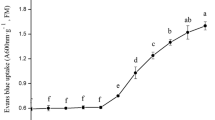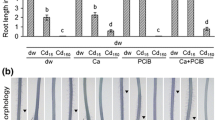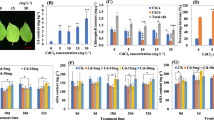Abstract
Abscisic acid (ABA), a widely known phytohormone involved in the plant response to abiotic stress, plays a vital role in mitigating Cd2+ toxicity in herbaceous species. However, the role of ABA in ameliorating Cd2+ toxicity in woody species is largely unknown. In the present study, we investigated ABA restriction on Cd2+ uptake and the relevance to Cd2+ stress alleviation in Cd2+-hypersensitive Populus euphratica. ABA (5 μM) markedly improved cell viability and growth but reduced membrane permeability in CdCl2 (100 μM)-stressed P. euphratica cells. Moreover, ABA significantly increased the activity of the antioxidant enzymes catalase (CAT), superoxide dismutase (SOD), and ascorbate peroxidase (APX), contributing to the scavenging of Cd2+-elicited H2O2 within P. euphratica cells during the period of CdCl2 exposure (100 μM, 24–72 h). ABA alleviation of Cd2+ toxicity was mainly the result of ABA restriction of Cd2+ uptake under Cd2+ stress. Steady-state and transient flux recordings showed that ABA inhibited Cd2+ entry into Cd2+-shocked (100 μM, 30 min) and short-term-stressed P. euphratica cells (100 μM, 24–72 h). Non-invasive micro-test technique data showed that H2O2 (3 mM) stimulated the Cd2+-elicited Cd2+ influx but that the plasma membrane (PM) Ca2+ channel inhibitor LaCl3 blocked it, suggesting that the Cd2+ influx was through PM Ca2+-permeable channels. These results suggested that ABA up-regulated antioxidant enzyme activity in Cd2+-stressed P. euphratica and that these enzymes scavenged the Cd2+-elicited H2O2 within cells. The entry of Cd2+ through the H2O2-mediated Ca2+-permeable channels was subsequently restricted; thus, Cd2+ buildup and toxicity were reduced in the Cd2+-hypersensitive species, P. euphratica.








Similar content being viewed by others
References
Chen S, Polle A (2010) Salinity tolerance of Populus. Plant Biol 12:317–333
Chen S, Li J, Wang S, Hüttermann A, Altman A (2001) Salt, nutrient uptake and transport, and ABA of Populus euphratica, a hybrid in response to increasing soil NaCl. Trees 15:186–194
Chen S, Li J, Wang T, Wang S, Polle A, Hüttermann A (2002a) Osmotic stress and ion-specific effects on xylem abscisic acid and the relevance to salinity tolerance in poplar. J Plant Growth Regul 21:224–233
Chen S, Li J, Fritz E, Wang S, Hüttermann A (2002b) Sodium and chloride distribution in roots and transport in three poplar genotypes under increasing NaCl stress. For Ecol Manage 168:217–230
Chen S, Li J, Wang S, Fritz E, Hüttermann A, Altman A (2003) Effects of NaCl on shoot growth, transpiration, ion compartmentation, and transport in regenerated plants of Populus euphratica and Populus tomentosa. Can J For Res 33:967–975
Chen S, Hawighorst P, Sun J, Polle A (2014) Salt tolerance in Populus: significance of stress signaling networks, mycorrhization, and soil amendments for cellular and whole-plant nutrition. Environ Exp Bot 107:113–124
Chmielowska-Bak J, Gzyl J, Rucinska-Sobkowiak R, Arasimowicz-Jelonek M, Deckert J (2014) The new insights into cadmium sensing. Front Plant Sci 5:245
Clemens S (2006) Toxic metal accumulation, responses to exposure and mechanisms of tolerance in plants. Biochimie 88:1707–1719
DalCorso G, Farinati S, Maistri S, Furini A (2008) How plants cope with cadmium: staking all on metabolism and gene expression. J Integr Plant Biol 50:1268–1280
di Toppi LS, Gabbrielli R (1999) Response to cadmium in higher plants. Environ Exp Bot 41:105–130
Elobeid M, Göbel C, Feussner I, Polle A (2012) Cadmium interferes with auxin physiology and lignification in poplar. J Exp Bot 63:1413–1421
Finkelstein RR, Gampala SSL, Rock CD (2002) Abscisic acid signaling in seeds and seedlings. Plant Cell 14:S15–S45
Gallego SM, Pena LB, Barcia RA, Azpilicueta CE, Iannone MF, Rosales EP, Zawoznik MS, Groppa MD, Benavides MP (2012) Unravelling cadmium toxicity and tolerance in plants: insight into regulatory mechanisms. Environ Exp Bot 83:33–46
Guo W, Chen R, Gong Z, Yin Y, Ahmed S, He Y (2012) Exogenous abscisic acid increases antioxidant enzymes and related gene expression in pepper (Capsicum annuum) leaves subjected to chilling stress. Genet Mol Res 11:4063–4080
Han Y, Wang W, Sun J, Ding M, Zhao R, Deng S, Wang F, Hu Y, Wang Y, Lu Y, Du L, Hu Z, Diekmann H, Shen X, Polle A, Chen S (2013) Populus euphratica XTH overexpression enhances salinity tolerance by the development of leaf succulence in transgenic tobacco plants. J Exp Bot 64:4225–4238
Han Y, Sa G, Sun J, Shen Z, Zhao R, Ding M, Deng S, Lu Y, Zhang Y, Shen X, Chen S (2014) Overexpression of Populus euphratica xyloglucan endotransglucosylase/hydrolase gene confers enhanced cadmium tolerance by the restriction of root cadmium uptake in transgenic tobacco. Environ Exp Bot 100:74–83
Hsu YT, Kao CH (2003) Role of abscisic acid in cadmium tolerance of rice (Oryza sativa L.) seedlings. Plant Cell Environ 26:867–874
Hsu YT, Kao CH (2005) Abscisic acid accumulation and cadmium tolerance in rice seedlings. Physiol Plant 124:71–80
Iakimova ET, Woltering EJ, Kapchina-Toteva VM, Harren FJM, Cristescu SM (2008) Cadmium toxicity in cultured tomato cells-role of ethylene, proteases and oxidative stress in cell death signaling. Cell Biol Int 32:1521–1529
Jiang M, Zhang J (2002) Water stress-induced abscisic acid accumulation triggers the increased generation of reactive oxygen species and up-regulates the activities of antioxidant enzymes in maize leaves. J Exp Bot 53:2401–2410
Li S, Leng Y, Feng L, Zeng X (2014) Involvement of abscisic acid in regulating antioxidative defense systems and IAA-oxidase activity and improving adventitious rooting in mung bean [Vigna radiata (L.) Wilczek] seedlings under cadmium stress. Environ Sci Pollut Res 21:525–537
Lux A, Martinka M, Vaculík M, White PJ (2011) Root responses to cadmium in the rhizosphere: a review. J Exp Bot 62:21–37
Ma W, Xu W, Xu H, Chen Y, He Z, Ma M (2010) Nitric oxide modulates cadmium influx during cadmium-induced programmed cell death in tobacco BY-2 cells. Planta 232:325–335
Ma T, Wang J, Zhou G, Yue Z, Hu Q, Chen Y, Liu B, Qiu Q, Wang Z, Zhang J, Wang K, Jiang D, Gou C, Yu L, Zhan D, Zhou R, Luo W, Ma H, Yang Y, Pan S, Fang D, Luo Y, Wang X, Wang G, Wang J, Wang Q, Lu X, Chen Z, Liu J, Lu Y, Yin Y, Yang H, Abbott RJ, Wu Y, Wan D, Li J, Yin T, Lascoux M, Difazio SP, Tuskan GA, Wang J, Liu J (2013) Genomic insights into salt adaptation in a desert poplar. Nat Commun 4:2797
Perfus-Barbeoch L, Leonhardt N, Vavasseur A, Forestier C (2002) Heavy metal toxicity: cadmium permeates through calcium channels and disturbs the plant water status. Plant J 32:539–548
Polle A, Chen S (2015) On the salty side of life: molecular, physiological and anatomical adaptation and acclimation of trees to extreme habitats. Plant Cell Environ 38:1794–1816
Polle A, Klein T, Kettner C (2013) Impact of cadmium on young plants of Populus euphratica and P. × canescens, two poplar species that differ in stress tolerance. New For 44:13–22
Rodríguez-Serrano M, Romero-Puertas MC, Pazmiño DM, Testillano PS, Risueño MC, del Río LA, Sandalio LM (2009) Cellular response of pea plants to cadmium toxicity: cross talk between reactive oxygen species, nitric oxide, and calcium. Plant Physiol 150:229–243
Sandalio LM, Rodríguez-Serrano M, del Río LA, Romero-Puertas MC (2009) Reactive oxygen species and signaling in cadmium toxicity. In: del Río LA, Puppo A (eds) Reactive oxygen species in plant signaling. Springer, Berlin, pp 175–190
Sasaki A, Yamaji N, Yokosho K, Ma JF (2012) Nramp5 is a major transporter responsible for manganese and cadmium uptake in rice. Plant Cell 24:2155–2167
Schützendübel A, Schwanz P, Teichmann T, Gross K, Langenfeld-Heyser R, Godbold DL, Polle A (2001) Cadmium-induced changes in antioxidative systems, hydrogen peroxide content, and differentiation in scots pine roots. Plant Physiol 127:887–898
Sun J, Chen S, Dai S, Wang R, Li N, Shen X, Zhou X, Lu C, Zheng X, Hu Z, Zhang Z, Song J, Xu Y (2009) NaCl-induced alternations of cellular and tissue ion fluxes in roots of salt-resistant and salt-sensitive poplar species. Plant Physiol 149:1141–1153
Sun J, Wang M, Ding M, Deng S, Liu M, Lu C, Zhou X, Shen X, Zheng X, Zhang Z, Song J, Hu Z, Xu Y, Chen S (2010a) H2O2 and cytosolic Ca2+ signals triggered by the PM H+-coupled transport system mediate K+/Na+ homeostasis in NaCl-stressed Populus euphratica cells. Plant Cell Environ 33:943–958
Sun J, Li L, Liu M, Wang M, Ding M, Deng S, Lu C, Zhou X, Shen X, Zheng X, Chen S (2010b) Hydrogen peroxide and nitric oxide mediate K+/Na+ homeostasis and antioxidant defense in NaCl-stressed callus cells of two contrasting poplars. Plant Cell Tissue Organ Cult 103:205–215
Sun J, Zhang C, Deng S, Lu C, Shen X, Zhou X, Zheng X, Hu Z, Chen S (2012a) An ATP signalling pathway in plant cells: extracellular ATP triggers programmed cell death in Populus euphratica. Plant Cell Environ 35:893–916
Sun J, Zhang X, Deng S, Zhang C, Wang M, Ding M, Zhao R, Shen X, Zhou X, Lu C, Chen S (2012b) Extracellular ATP signaling is mediated by H2O2 and cytosolic Ca2+ in the salt response of Populus euphratica cells. PLoS ONE 7:e53136
Sun J, Wang R, Zhang X, Yu Y, Zhao R, Li Z, Chen S (2013) Hydrogen sulfide alleviates cadmium toxicity through regulations of cadmium transport across the plasma and vacuolar membranes in Populus euphratica cells. Plant Physiol Biochem 65:67–74
Thompson AJ, Andrews J, Mulholland BJ, McKee JMT, Hilton HW, Horridge JS, Farquhar GD, Smeeton RC, Smillie IRA, Black CR, Taylor IB (2007) Overproduction of abscisic acid in tomato increases transpiration efficiency and root hydraulic conductivity and influences leaf expansion. Plant Physiol 143:1905–1917
Wang R, Chen S, Deng L, Fritz E, Hüttermann A, Polle A (2007) Leaf photosynthesis, fluorescence response to salinity and the relevance to chloroplast salt compartmentation and anti-oxidative stress in two poplars. Trees 21:581–591
Wang R, Chen S, Zhou X, Shen X, Deng L, Zhu H, Shao J, Shi Y, Dai S, Fritz E, Hüttermann A, Polle A (2008) Ionic homeostasis and reactive oxygen species control in leaves and xylem sap of two poplars subjected to NaCl stress. Tree Physiol 28:947–957
Wang J, Chen J, Pan K (2013a) Effect of exogenous abscisic acid on the level of antioxidants in Atractylodes macrocephala Koidz under lead stress. Environ Sci Pollut Res 20:1441–1449
Wang F, Deng S, Ding M, Sun J, Wang M, Zhu H, Han Y, Shen Z, Jing X, Zhang F, Hu Y, Shen X, Chen S (2013b) Overexpression of a poplar two-pore K+ channel enhances salinity tolerance in tobacco cells. Plant Cell Tissue Organ Cult 112:19–31
White PJ (1998) Calcium channels in the plasma membrane of root cells. Ann Bot 81:173–183
Yang R, Yang T, Zhang H, Qi Y, Xing Y, Zhang N, Li R, Weeda S, Ren S, Ouyang B, Guo Y (2014) Hormone profiling and transcription analysis reveal a major role of ABA in tomato salt tolerance. Plant Physiol Biochem 77:23–34
Zhu JK (2002) Salt and drought stress signal transduction in plants. Annu Rev Plant Biol 53:247–273
Zhu X, Jiang T, Wang Z, Lei G, Shi Y, Li G, Zheng S (2012) Gibberellic acid alleviates cadmium toxicity by reducing nitric oxide accumulation and expression of IRT1 in Arabidopsis thaliana. J Hazard Mater 239–240:302–307
Acknowledgments
The research was supported jointly by the Beijing Forestry University Young Scientist Fund (Grant No. BLX005), the National Natural Science Foundation of China (Grant Nos. 31270654, 31200207, 31200470, 31570587, 31500504), the Research Project of the Chinese Ministry of Education (Grant No. 113013A), the key project for Oversea Scholars by the Ministry of Human Resources and Social Security of PR China (Grant No. 2012001), the Program for Changjiang Scholars and Innovative Research Teams in University (Grant No. IRT13047), the Program of Introducing Talents of Discipline to Universities (111 Project, Grant No. B13007), the Fundamental Research Funds for the Central Universities (Grant No. TD2012-04), the Research Support Project of Shanxi University (Grant No. 113533801004), and the Plan Project for Scientific Research and Entrepreneurship Action of College Students in Beijing (Grant No. S201510022037).
Author information
Authors and Affiliations
Corresponding author
Additional information
Yansha Han, Shaojie Wang, and Nan Zhao contributed equally to this work.
Electronic supplementary material
Below is the link to the electronic supplementary material.
Rights and permissions
About this article
Cite this article
Han, Y., Wang, S., Zhao, N. et al. Exogenous Abscisic Acid Alleviates Cadmium Toxicity by Restricting Cd2+ Influx in Populus euphratica Cells. J Plant Growth Regul 35, 827–837 (2016). https://doi.org/10.1007/s00344-016-9585-2
Received:
Accepted:
Published:
Issue Date:
DOI: https://doi.org/10.1007/s00344-016-9585-2




